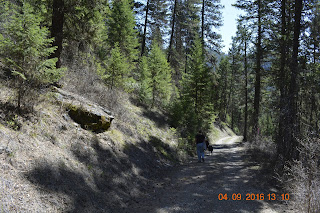But what if you have many scales? What if you don't have the space or money to build a dedicated layout for every possible size train you own? This right here is the solution, glue a rug on top of a door, lay down some track, and have fun!
And so I give you, the door layout!
This whole setup cost about $80, was built in 2 hours, and I had trains running by the end of the afternoon!
To lay things out, here's the step by step process:
STEP ONE:
You'll need:
- A hollow-core door as wide as you can get, but 36 inches is sufficient
- An indoor/outdoor grass rug with short fibers. Size will have to be at least as big as the door.
- A can of spray adhesive
- A can of spray paint (chose black, but any color of your choosing works fine)
- A small box (50-100) screws with a pan head to secure the perimeter of the rug
The first thing to do is take your door, peel off any stickers, and spray the edge of the door. You could do the underside if you wanted, but just the edges will be fine, it'll give a trim and professional look.
STEP TWO:
Gluing the rug to the door.
Once the paint is dry (10-20 minutes for the quick-dry paint) the gluing can begin! First, unroll your grass mat and decide which side you want to face up. For mine, one side was clearly meant to be the 'down' side of the mat and the other was clearly the 'up' side. So take the 'up' side and be sure to roll the rug so that it is on the INSIDE of the roll, not the outside. That way, when you unroll the rug onto the door with fresh glue, you won't be gluing the wrong side.
After applying the adhesive, slowly unroll the mat over the door, being sure to keep the mat straight and flat against the door's surface. Once the door has been covered, run your hand over the mat to smooth out any wrinkles or air pockets. This is important so that N and HO scale trains can be ran without trouble.
STEP THREE:
Securing the perimeter.
Now that the rug has been applied to the door, you may wish to further protect the rug from having it's edges tore up or de-laminating from the door's face. To do so, the best and simplest way is to secure the perimeter with short screws with a pan head. The wide head of the screws holds the mat better than drywall screws or screws with a countersinking head.
To keep the screws in line with each other, I used a straight edge to space the screws apart evenly. I worked from one side to the center, and then went to the other side and did the same. The result was a fairly straight line of screws, evenly spaced, that didn't spoil the professional look of the table.
STEP FOUR:
Trimming the rug.
Depending on what material your rug is made of, you may have to use a knife, serrated steak knife, or even a saw or a rug cutting tool. My grass mat merely required a sharp box cutter blade so I flipped the table over and cut along the edge, leaving about 1/4" of overhang. The result was this:
One last thing to note:
I didn't add any legs to this table. To do so would require adding 2x4 bracing under the layout to strengthen the luan plywood. However, if you happen to have an old table or a couple of sawhorses, you can have the layout elevated without much cost or effort.


























































































